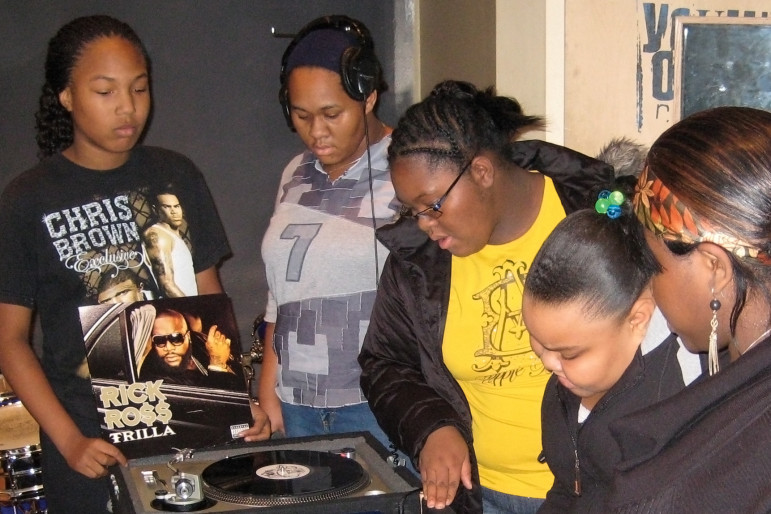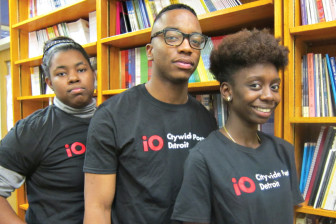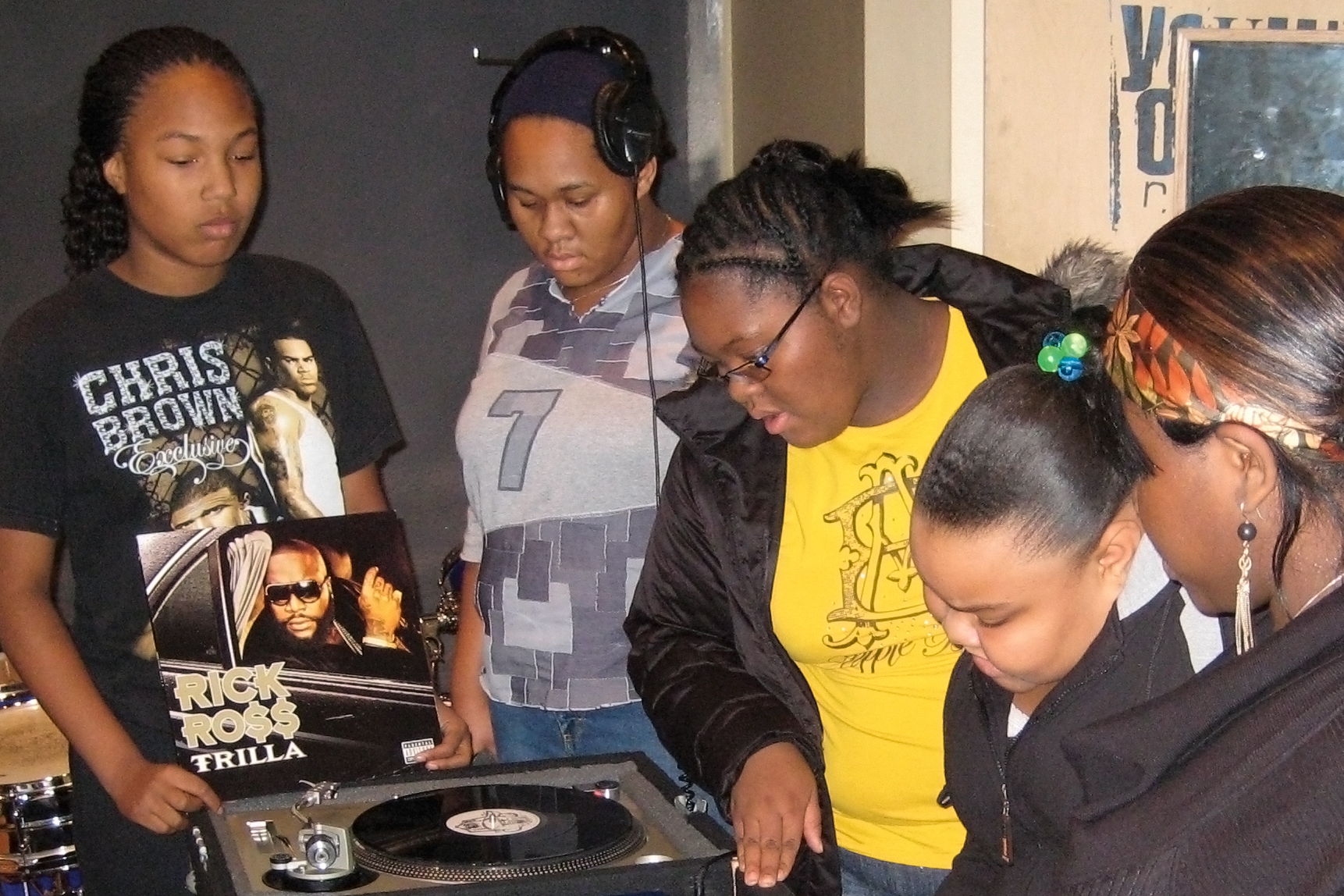
The Neutral Zone
The Neutral Zone is a teen center in Ann Arbor, Mich., where teenagers take leadership in running the organization. They facilitate programs and have seats on the board of directors.
See sidebar “Lessons from the Youth-Driven Spaces Project”
Wei Wen Balter was a new kid in town when he first set foot in the teen center in Ann Arbor, Mich., known as the Neutral Zone. Some acquaintances had told him about a program at the center that advocated for gay, lesbian and gender-questioning youth.
He had no idea that two years later he’d be a member of organization’s board of directors.
The 17-year-old senior at Skyline High School is now one of 13 teenagers on the 29-person board tasked with governing the center. He reviews financial information and helps make decisions about the operation, among other things.
“It’s a really cool perspective to sit on the board with all of the really experienced and smart adults,” said another teenage board member, Isaac Scobey-Thal, 16.
Isaac initially spent some time listening and learning the ropes. Now, as a member of the board’s development committee, he contacts potential donors and explains why they might like to support the Neutral Zone.
Expanding the role of youth in leadership
The concept of helping teens develop leadership skills by actually leading is not new. Youth organizations have long encouraged community service and leadership in young people. More than 60 years ago, teens were going to their state capitols to take part in mock legislative sessions through the Youth in Government program. More recently, the positive youth-development approach has called for actively engaging young people in decision-making in order to develop skills that will help them not only flourish but also influence the successes of their own programs as well.
Some after-school programs for younger kids now seek to give kids more say in the activities they pursue. The approach can be used with kids of all ages, but it especially meets the needs of teenagers.
Nevertheless, few organizations have young people fully running the show.
John Weiss, executive director of Neutral Zone, said the operation of the organization is a pathway for teens to learn new skills.
They develop valuable skills such as identifying problems, analyzing and creating solutions. “Schools don’t spend enough time allowing the development of 21st century skills,” Weiss said.
It’s also a way to engage older kids in out-of-school-time programs, which see a large drop-off as kids get older. And “it’s about democracy and civic engagement,” Weiss asserted.
Young people often are not seen as competent, he said, but in youth-driven spaces adults come to see their competence.
About six years ago Neutral Zone began using the term “youth-driven space,” which describes a program in which young people partner with adults to play meaningful decision-making roles. Youth make decisions in programming and in governing the organization.
Youth-leadership pioneers

InsideOut
From left: Arzeila Williams, Terrell Morrow and Kennedie King, an InsideOut Writers group from Detroit.
The concept isn’t the Neutral Zone’s alone. In 1993, five years after a Supreme Court ruling that First Amendment freedom of speech did not extend to school newspapers, VOX Teen Communications was founded in Atlanta. It was organized by teens and young adults to publish an uncensored teen newspaper and from the beginning included youth as decision-makers. Founder Rachel Alterman Wallack, then 23, brought together interested students, who planned the publication and the nonprofit’s mission. Today, six teenagers sit on a board of 26. (Wallack is also contibuting editor of Youth Today.)
Adult staff members at VOX function as “a guide on the side,” said Executive Director Jeff Romig. “We’re there to ask questions.”
Teens are involved in fundraising and strategic planning and are treated as equals with adults, he said. Adult staff “ensure that business gets done, but teen participants are getting to grow as leaders,” he said.
Another youth-driven organization, Boston-based Youth on Board, was formed in 1994 to change how youth and adults work together, said Associate Director Rachel Gunther. Founder Karen Young was part of the national service movement of the late 1980s which urged citizens to volunteer in order to solve critical social issues. Ten years ago, Youth on Board received a contract from the Pew Charitable Trust to run trainings in schools around the country to set up student decision-making groups.
Currently the organization, which is part of YouthBuild, coordinates the Boston Student Advisory Council for Boston Public Schools. It has pushed for policies to ensure student feedback in teacher evaluation and published a book: “15 Points: Successfully Involving Youth in Decision-Making.”
Adoption of the model requires strong commitment
The movement toward youth-driven organizations is not widespread across the country. Thanks to the Neutral Zone, however, it has growing momentum in Michigan.
“People are very interested in [the model],” said Ravi Ramaswamy, training coordinator at the David P. Weikart Center for Youth Program Quality, which collaborated with the Neutral Zone for capacity-building at organizations interested in this model.
“But it’s not like you go out and train people for a day and you’re done,” he said.
It takes a strong commitment at the policy level and lots of time at the staff level, Ramaswamy said.
He considers it a unique opportunity for out-of-school time programs.
“It’s a space where skills can be practiced in a real and authentic way,” he said.
“Ultimately every organization that wants to go for high quality should find a way to involve youth participants – and certainly with older youth,” he said.
Youth voice as a best practice
“High quality programs focus on giving youth a say in programming,” said Nikki Yamashiro, research associate for the Afterschool Alliance. “It gives them a sense of ownership … and a sense of empowerment.”
For organizations that want to explore the youth-driven concept, Weiss advises starting with a small project to experience a quick success. Young people can increase their contribution to the organization, and adults can start to see their competence.
Many organizations start at the programming level, Weiss said.
For example, InsideOut Literary Arts Project is a Detroit nonprofit that puts writers-in-residence in 27 schools. It also offers an out-of-school program called City Wide Poets. Last winter, staff and writers took part in a one-day training in Ann Arbor.
It was an introduction to the youth-driven model, said Alise Alousi, associate director of InsideOut. The goal was to incorporate some of the ideas of a youth-driven space into the classroom and to create more connection between InsideOut’s school and out-of-school programs.
One result of the training was the creation of a poem by three students for an annual Martin Luther King Jr. celebration in Detroit.
The poem was, in part, the students’ response to an online comment that belittled the value of teaching poetry to Detroit students.
Teens Arzelia Williams, 17, Kennedie King, 16, and Terrell Morrow, 19, researched and wrote the performance piece and worked on ways to engage the audience.
InsideOut is also starting an online poetry journal that will be run by the teens.
Creating a youth-driven pace
At the Neutral Zone, a teen advisory council must approve any new program. Currently about 20 are offered.
“Each weekly program is facilitated by a young person with the support of an adult adviser,” Weiss explained.
The council is also involved in staff hiring and takes responsibility for the building.
The organization began in 1998 when a group of teens wanted a place to come together for music and other creative pursuits. Initially, teens and adults worked together to renovate a building. The kids created activities that they wanted, including a music venue called Breakin’ Curfew where local bands could perform.
Steve Hall, a teen board member in the early years, took part in a video that celebrated the center’s 13th anniversary. He recalled the first time he went to a concert at the Neutral Zone. As he hauled his equipment up the old stairs he was struck by all the art painted directly on the walls.
“I was surrounded by musicians and poets and artists and all these cool people,” he said. He realized: “This is where they all hang out.”
Molly Raynor was the teen founder of North Star, a discussion group for young women at the Neutral Zone. She was also active in the VOLUME Poetry Project.
Teens from a local gay-straight alliance were invited to start some activities at the Neutral Zone. It grew into a program called Riot Youth, which went on to create Gayrilla theater performances. Riot Youth is the program that first drew in Wei Wen Balter.
“If I hadn’t had the support of Neutral Zone, who knows where I’d be today,” Balter said. For one thing, he said, he was just about the only out and queer student at Skyline High.
“It saved my life,” he said of the Neutral Zone.
Kids often say that about the place, he added.
At the Neutral Zone, teens make real decisions, plan real activities and do real outreach in the community, said teen board member Scobey-Thal.
That’s not something a lot of teenagers get to do, he said.
Balter summed it up: “We’re on the forefront of something that’s pretty big.”
See sidebar “Lessons from the Youth-Driven Spaces Project”
































